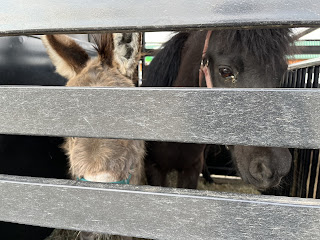It was a cold, blustery morning when we left Kirksville and the temperature would only drop further as we headed north. Our thoughts were on getting the goats, pony, cow, and donkey to warm stalls in Minnesota. The goats and donkey were in the front of the trailer where they could avoid much of the wind. Goats are most susceptible to getting chilled. The cow and pony still had some pretty thick coats and appeared much more comfortable. The map program led us on dirt roads heading north into Iowa. It was slow going over old winter ruts along rural roads. I doubted my map program and checked the direction to ensure we were heading the right way. Eventually, it dumped us onto a secondary paved road and then joined a highway. The differences in the landscape from Florida to the northern Midwest were as if we were traveling backwards from full spring through early spring, and then into late winter. The trees were still bare and very little green, even from ditches along the highway. Thankfully, despite being in the twenties, there was no snow on the ground and zero ice. It was dry, cold, and sunny. It reminded me of northern Colorado and the seemingly constant winds that would blow across our little front range town. It wasn’t quite as dry as the squeezed out winds that came off the mountains, but the slightly higher humidity made it more cruel. Of all the welcome signs of the many states we had crossed into, Minnesota’s was the most attractive. Partly because we were almost home, and partly because it used native rock.
We were here. The land of Vikings and funny phrases. Hot dishes and walleye. Snow, prairies, lakes, and rivers. As a graduate student in ecology, I looked at unfamiliar forms and realized just how much I had to learn. Memorizing new Latin names of plants. Understanding new weather patterns and new relationships between new-to-me species. I was comforted by the fact that my graduate program, through Colorado State, emphasized prairie and riparian ecosystems, but I was still intimidated by how much information I would have to fill in. I saw oak trees, which in a landscape have a similar role, regardless of ecosystem. There were maples and hickories. I spotted the remnants of dormant tall grass prairie in a local conservation area. I wondered what our new farm would look like. We never had time to fly up to see it. We had to trust the agent based on one trip to the area (my husband’s employer refused to give him time off once he gave notice). The large animals would have new things to eat this year. Poor Fiona had been a lone cow with goats as her only friends for months. Perhaps there was wisdom in getting a local heifer for company and to show her the good things to eat in her new pasture.
A local charity farm had room for the large animals for a few days and the small animals went to a pet boarding place for at least a few days. We still had our two hotel cats and dog, but the bunnies had a nice run at the pet boarder. We slept restlessly knowing the next day would bring the closing and first walk though of our new farm. I had ordered and paid for round pen panels to pick up and house the large animals temporarily until we could arrange what fencing was needed. The plan was for us to stay at the new house the following night. I had air mattresses, bedding, basic kitchen utensils, and a coffee maker in bins in the back of my truck, along with the animals’ feed, buckets, water troughs, health certificates, and emergency vet kit. Just one more night in a hotel.





No comments:
Post a Comment